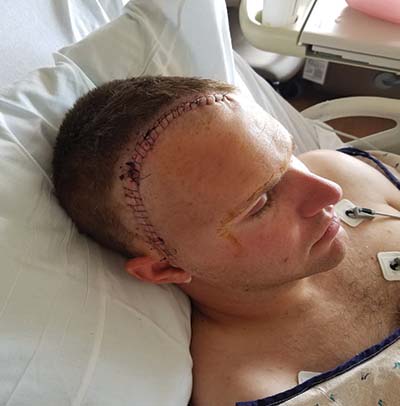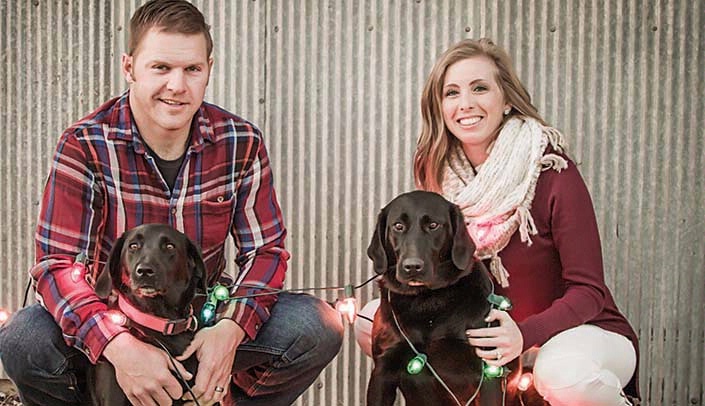Kendyl Ziesler wrote this blog about her husband’s battle with a stroke and two brain aneurysms. Derek Zeisler is one of the patients who will be profiled on signage along the route of Saturday’s American Heart Association Heart Walk. (See sidebar for details on the event.)
In the spring of 2016, my husband Derek was suffering from frequent headaches and neck pain. When chiropractic adjustments, trips to his primary caregiver and physical therapy did not provide relief, he ended up going to his local emergency room. We stressed the importance of Derek’s medical history — he was a survivor of a ruptured brain aneurysm that had been coiled in March of 2006.
 |
On August 11, 2016, Derek had a craniotomy at Nebraska Medicine. |
Upon arrival, his new neurosurgery team quickly sprang into action. They took Derek into the operating room to attempt to coil the leaking aneurysm. This was done in Interventional Radiology (IR) where they gained access through his groin. Neurosurgeon Daniel Surdell, M.D., and his team were able to coil and temporarily secure the bleeding aneurysm. While in the procedure, Dr. Surdell also found a second aneurysm located across the same vessel and decided that both the old and new aneurysm would need to be permanently repaired via a craniotomy. We were told his recovery would be a strict two weeks in the Neuro-ICU with close monitoring of his blood pressure and vasospasms in the brain.
Register to walk
Volunteers will be in the Nebraska Cafe entrance today from 11:30 a.m. to 12:30 p.m. to register those who are interested in walking.
On June 11, 2016, I was called around 5 a.m. by Derek’s night nurse to inform me that they had ordered a scan due to worsening in weakness and response on his left side. The scan revealed narrowing of Derek’s right carotid artery branch due to the severe vasospasms in his brain. William Thorell, M.D., and his team quickly rushed Derek to IR again where they ballooned open the “string-bean”-like vessel that had resulted in his frontal lobe stroke. Derek was transferred back up to his Neuro-ICU room on a ventilator. At this point in time, Derek was unable squeeze or move his left arm/hand or move his left leg/foot. Dr. Thorell also described Derek as having left-sided neglect — where basically the left side of his world did not exist. But, optimism was grasped as Dr. Thorell thought that most of the tissue would be recoverable with time and patience.
On June 15, 2016, a decision was made by Andrew Gard, M.D., to take Derek to IR to balloon open his right-sided artery again due to the upward trend of vasospasms. This was done to prevent any further stroke from happening. The main goal at this point was to stay ahead of the vasospasms and rest.
After two weeks in Nebraska Medicine’s Neuro-ICU and the start of physical therapy (PT), occupational therapy (OT), and speech therapy (ST); Derek was transferred to the Neuro Step Down Unit. A plan was made to attend inpatient rehab at Methodist Hospital to recover to the best of his abilities before returning for his craniotomy. Derek had to regain all of his strength back in his left side, learn to walk with no assistive devices, and work on his conversation/emotional characteristics. Derek spent nine days in inpatient rehab where he regained the majority of his independence back. This was an absolute miracle to witness, given all of the turmoil his body and mind had gone through. Derek continued to attend outpatient rehab twice a week to continue to work on PT, OT, and ST in hopes to recover even more.
After spending the summer at his mother’s house in Omaha, we returned to Nebraska Medicine on Aug. 11, 2016, for Derek’s craniotomy. This was performed by Dr. Surdell and his team. The attempt would be made to clip and secure both aneurysms if able to. This was considered to be more of a “permanent” fix over the coil. Dr. Surdell and his team were able to clip off both aneurysms. He noticed a lot of scar tissue where the two prior hemorrhage sites were. He now has medal plates and screws in his head and had a pretty gnarly incision. Derek was transferred back to Neuro-ICU for two days where he battled severe nausea and vomiting. After an additional two days on the Neuro Step Down Unit, we were able to bring Derek back to his mother’s house where he would continue to recover and heal.
In the beginning of September 2016, we returned to our country home in Wahoo, Neb. This was a huge step in the summer of unfortunate events. Derek had a follow up angiogram in December where the clippings looked good. He has since began working, where his only downfall is not having 100 percent of his strength and stamina back. We are so blessed and fortunate for such an extraordinary neurosurgery team at Nebraska Medicine that saved Derek’s life. The knowledge and expertise displayed by his whole care team was truly astonishing. We are forever in debt to all that healed and cared for him during this nightmare.

What a journey!! Thanks for sharing.